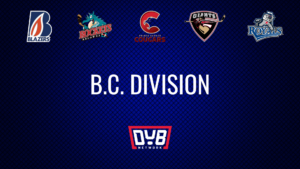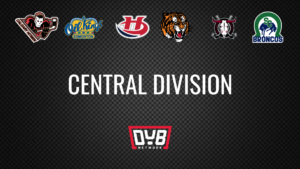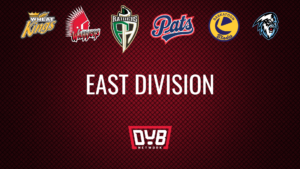The Portland Winterhawks 68-game schedule is now three-fourths complete, and I’ve taken a glance at the numbers to spot anything which catches my eye. My goal is to provide information beyond what someone could quickly view on the season statistics page.
For this report I only included active roster skaters. Any player no longer on the team whether by trade, release, or any other reason are not included.
Shane Farkas and Joel Hofer are not included in the offensive numbers, but have been included in their own section.
Due to limited sample size, Tyson Kozak’s numbers are not included either.
A first glance at the main statistics broken down by age:
| Age | Number of Players | Goals | Assists | Points | Plus/Minus |
| 16 | 3 | 24 | 35 | 59 | 7 |
| 17 | 5 | 36 | 67 | 103 | 34 |
| 18 | 5 | 22 | 44 | 66 | 57 |
| 19 | 5 | 66 | 124 | 190 | 46 |
| 20 | 3 | 57 | 88 | 145 | 26 |
| Grand Total | 21 | 205 | 358 | 563 | 170 |
| Age | Number of Players | Power Play Goals | Power Play Assists | Game Winning Goals | Shorthanded Goals | Shorthanded Assists |
| 16 | 3 | 4 | 4 | 3 | 0 | 0 |
| 17 | 5 | 3 | 12 | 7 | 2 | 0 |
| 18 | 5 | 1 | 2 | 3 | 0 | 0 |
| 19 | 5 | 28 | 34 | 5 | 4 | 7 |
| 20 | 3 | 18 | 47 | 10 | 4 | 2 |
| Grand Total | 21 | 54 | 99 | 28 | 10 | 9 |
16’s – Fromm-Delorme, Hanas, Jarvis
17’s – Dureau, Hanus, Newkirk, Nolan, Perna
18’s – Cicek, Delorme, Kvasnica, Ludvig, Mannek
19’s – Gilliss, Glass, Gricius, Paterson, Quigley
20’s – Blichfeld, De Jong, Freadrich
Goals
When I reviewed the first half of the season, the Winterhawks were on pace to score 276 goals. After 51 games, if Portland were to keep the scoring pace, this number would slightly increase to 278. For perspective, in 72 games last season the Winterhawks netted 274.
At the halfway mark, Joachim Blichfeld, Cody Glass, Reece Newkirk, and Jake Gricius accounted for 60 percent of the team’s goals. Those same four now make up 47 percent of the team’s 209 goals in the first 51 games.
Two players have significantly increased their goal scoring pace over the past 17 games, Seth Jarvis and Lane Gilliss.
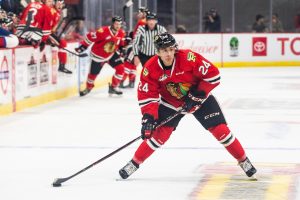
Jarvis increased from 0.21 goals per game to 0.30. The 16-year-old rookie picked up five goals on the eastern swing in early January to help fuel his second half numbers. The Winnipeg native’s first season in the WHL is proving to be note worthy. Comparing his first year to Cody Glass’ and Skyler McKenzie’s 16-year-old seasons, Jarvis so far has the same amount of goals as Glass and McKenzie had combined during their entire freshman seasons.
19-year-old Lane Gilliss also saw his numbers rise from 0.15 to 0.24 goals per game over the middle 34 games in the season. His chemistry with Michal Kvasnica and Robbie Fromm-Delorme is starting to show up on the score sheet. 10 of GIlliss’ 12 goals have come via five-on-five play giving Portland depth scoring from their fourth line.
Joachim Blichfeld, the WHL’s leading goal scorer with 43, pace slowed slightly from 0.91 to 0.84 goals per game. A big stretch of recent games have been played without linemate Cody Glass. If the overage import from Denmark continues on his scoring pace he will finish the season with 57 goals.
Of the team’s first 138 goals, 60 percent were scored by 19 and 20-year-olds. With 209 goals scored, and 17 games to play, this number dropped to 58 percent of goals are credited to the eight players born in 1998 or 1999. The trend continues to decline as this statistic was 63 percent after the first 19 games this year.
Blichfeld took over the game-winning goals lead from Newkirk with seven, including four in the last 17 games. Kvasnica and Fromm-Delorme each picked up their first game-winning goal during the stretch giving Portland 11 players with at least one.
If current goal scoring pace continues over the final portion of games, the Winterhawks will have four players with over 20 goals (Blichfeld (57), Gricius (29), Newkirk (26), Josh Paterson (24))and three more with over 15 (Glass (19), Jarvis (19), Gilliss (16)).
Assists
On every scoring play there is an opportunity for two assists to be awarded; therefore, a total of 418 possible assists are available on Portland’s 209 goals. With three-fourths of the season completed, Portland has 358 assists across all players; good for 86 percent of the available amount. The Winterhawks remained on their same pace compared to the first half of the season, also 86 percent. Looking back to last year, this year’s total is only one percent less.
At the halfway mark of the season 1998 and 1999 born players accounted for 66 percent of the assists in my last review, and the number has decreased to 59 percent. After the first 19 games the number was as high as 72 percent.
Every other age group increased their share of assists:
- 16-year-olds: 8 percent to 10
- 17-year-olds: 17 percent to 18.7
- 18-year-olds: 9 percent to 12
As a result, the Winterhawks continue to get more production out of their younger players and are not solely relying on the top players to drive the scoring plays.
As expected, Blichfeld and Glass are the highest contributors of assists with 98 combined. However, the team relied less on the duo during games 35-51 (27 percent of total) than they did in the previous two portions of the season; games 1-19 (39 percent) and games 20-34 (32 percent). Again, depth scoring is starting to arrive for the Winterhawks.
Portland’s middle portion of the season has been played without the services of Cody Glass as he was away at the World Junior Championships and is now out day-to-day with a lower-body injury. Glass is two assists shy of the WHL lead despite playing in 15 less games than the leader (Trey Fix-Wolansky). Glass’s 1.46 assists-per-game is over half an assist-per-game higher than Blichfeld’s 0.92.
19-year-old Jake Gricius continues his upward trend on assists as the season progresses. After the first 19 games he was contributing 0.21 assists-per-game. With 34 games completed, the Colorado Springs native’s numbers more than doubled to 0.44. Now, after 51 contests his assists-per-game rests just over half an assist per game.
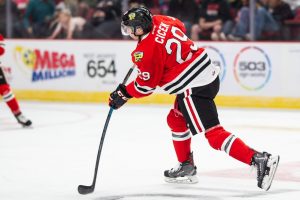
Nick Cicek by far took the biggest jump over the most recent portion of the schedule. Entering the last week of December, the 18-year-old rookie tallied one assist on the season, the first game of the year in Seattle. Over the next 17 games the Winnipeg native put up ten assists including three games with multiple assists.
Also, fellow rookie defenseman Nick Perna more than doubled his season total in assists. Through the first 34 games the Texas native contributed three assists, but after 51 games, the total increased to eight. Playing in 24 of the possible 51 games, the 17-year-old defenseman now averages an assist once every three games he is in the lineup.
During this stretch of games, forward Ryan Hughes was traded for Josh Paterson and two draft selections. Hughes is known for his offensive and creative ability. In the Winterhawks first 34 games, the 19-year-old assists-per-game were 0.44. After 51 games, Paterson’s numbers are 0.41, with the majority of his assists coming with Saskatoon. Portland fans have yet to see a significant drop in production.
Since the trade each player has seven points with their new team (Hughes: 2G-5A, Paterson: 4G-3A), with Hughes appearing in two fewer games.
Plus/Minus
Most are familiar with this statistic, but to be clear: a player earns a “plus” if they are on the ice for a goal scored at even strength or when a shorthanded goal is scored by their team. A player receives a “minus” if they are on the ice for a goal against at even strength or when a shorthanded goal is scored by their opponent. Being on the ice for a power-play goal for or against doesn’t impact a player’s plus/minus.
Many in the hockey community feel this statistic isn’t the best representation of a player given how many variables factor into this statistic. A player could just be jumping on or off the bench when a goal is scored, meaning they have no involvement in the goal. The player could also not be responsible for either the breakdown on defense or the offensive zone time on an offensive zone shift. However, until a better statistic is provided and available, I will continue to review this statistic.
Preparing to view Portland’s plus/minus statistics one expects to see Cody Glass and Joachim Blichfeld near the top given the amount of goals they score when on the ice; however, they are significantly behind defenseman John Ludvig.

Ludvig’s +32 rating is good for seventh in the WHL, and first among players not playing for Prince Albert. With Ludvig scoring 12 points, his high rating indicates he is on the ice keeping the puck out of the net, but also leading to offense. The 18-year-old defenseman is 12 higher than second on the team Blichfeld’s +20 who has 78 more points. Ludvig is truly a “throwback” or “old-school” defenseman for Portland.
Nick Cicek’s play in the defensive zone over the last 17 games shows up here. He is now third on the team in this category with a +16 rating, an increase of 12 since my last review.
Defenseman Clay Hanus and forward Lane Gilliss were each a -8 and -7 respectively after the first half of the season. Now, they are both back to an even rating.
Forwards Jake Gricius and Reece Newkirk each increased their rating by ten over the last segment of the campaign.
Each age group increased their plus/minus over the last 17 games:
- 16-year-olds: -6 to 7
- 17-year-olds: 9 to 34
- 18-year-olds: 25 to 57
- 19-year-olds: 19 to 46
- 20-year-olds: 13 to 26
At the midway portion of the season, Portland had seven players with a negative rating, with 17 games to play, the number is down to one.
Power Play Statistics
At the holiday break the Winterhawks power play was third in the WHL operating with a 27.2 percent efficiency rate. The Spokane Chiefs (28.4) and Moose Jaw Warriors (28.7) were the only teams with a higher percentage success rate than Portland.
However, recently, the Winterhawks power play has been in a funk going 1-for-31 on their man advantage opportunities.
With the lack of power-play goals, the Winterhawks power play dropped from third to fifth. Their efficiency rate is down to 23.7 percent, 4.8 behind the WHL leading Spokane Chiefs.
Portland however leads the league in power-play opportunities with 232, seven more than the Everett Silvertips.
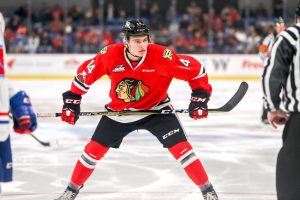
Jake Gricius took over the team lead in power-play goals from Joachim Blichfeld as the 19-year-old center now has 13 to the import’s 12. Recently acquired Josh Paterson is third on the team with nine.
Cody Glass (25), Blichfeld (24), and Jared Freadrich (15) are the team leaders in power-play assists.
Portland’s top power play unit is responsible for the majority of points and getting an increase in production from the second group will be key for the Winterhawks down the stretch run.
One area of strength though for Portland is not giving up shorthanded goals while on the power play. The Winterhawks are tied for third in the league only surrendering three goals with the man advantage. However, this number would increase to seven if goals were counted within the following 30 seconds after the power play expired.
Penalty Kill and Shorthanded Goals
Portland is currently third in the WHL in penalty kill percentage with 84.3 percent of penalties successfully killed. The Winterhawks declined over the most recent 17 games as they were successful killing 85.1 percent at the conclusion of 34 games. Prince Albert continues to lead the league in PK percentage with 87.1.
Similar to Portland leading the league in power-play opportunities, Portland is second in the league in times shorthanded with 236, 18 behind the Regina Pats.

In post game interviews the Winterhawks coaches continue to comment on the number of penalties taken per game. Through the first half of the season the team was shorthanded 5.11 times per game.
The message appears to be getting through. Now, after 51 games, the young Winterhawks have reduced this to 4.6, half a shorthanded chance less per game.
Despite being shorthanded so often, the Winterhawks now are up to second in the WHL for shorthanded goals for with ten. The Prince Albert Raiders are on fire, netting 20 while down a man.
Blichfeld has four shorthanded markers while Glass, Gricius, and Newkirk have two for Portland.
Jake Gricius is the catalyst for creating offensive shorthanded chances with four shorthanded assists, tied for the league lead.
Goaltending
At the trade deadline the Portland Winterhawks made one of the biggest splashes acquiring St. Louis Blues drafted netmind Joel Hofer in exchange for six draft picks. To make room for Hofer, Dante Giannuzzi returned home to Winnipeg before he is expected back for the playoffs as a black ace.
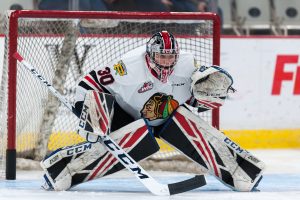
Since the acquisition of Hofer, the Winterhawks have played ten games.
So far, head coach Mike Johnston has started Hofer seven and Shane Farkas in three games.
Both Hofer and Farkas each have one shutout since the trade. Farkas’ shutout came on Friday evening against the B.C. Division leading Vancouver Giants. The 19-year-old made 24 saves in the 3-0 victory.
Hofer stopped 37 against the Lethbridge Hurricanes for his first shutout with the Winterhawks. Twice he came within 20 seconds of a shutout against the Everett Silvertips and Seattle Thunderbirds.
Since being acquired by Portland, Hofer reduced his goals against average from 4.02 to 3.785 on the season. In his seven starts with Portland his goals against average is 2.76. Joel’s save percentage also increased slightly from 0.904 to 0.906 on the year, and is 0.916 with Portland.

With Farkas used to starting the majority of the games this season, he had to adjust to playing the backup role more. Shane’s response includes a 2.51 goals against average and 0.912 save percentage over his three starts and one game of replacing Hofer against Spokane. His season numbers now are 2.83 goals against average and 0.902 save percentage.
A key storyline for Portland down the stretch will be how the starts are split among Hofer and Farkas.
Biggest surprises
In my opinion the improvement of Lane GIlliss has to be at the top of the list. The 19-year-old showed tremendous leadership and is starting to find the score sheet more often. His leadership includes both on and off the ice play. Taking Michal Kvasnica under his wing is just one example.
Rookie Seth Jarvis is second on my list. Everyone knew the rookie had the speed and skill to produce at the WHL level; however, he is showing he can contribute even as a 16-year-old. Many of the top rookies this season are 17-years-old. Portland’s next few seasons look bright as he has recently been playing on a line I’ve tabbed as the “futures” line: Seth Jarvis, Reece Newkirk, and Jaydon Dureau.
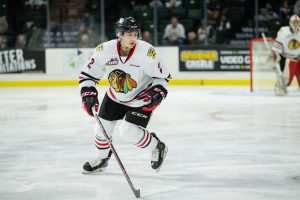
The trio of rookie defensemen, Nick Cicek, Kade Nolan, and Nick Perna, continue to impress. The three are battling for ice time, but are close off the ice as well. In speaking with the three throughout the first three-fourths of the season, each have commented about how their friendship pushes them on the ice.
Cicek has proven to be reliably defensively, but his offensive game stepped up recently as well. His ability to get shots through allows Portland to continue to get offense from the backend from their third pairing.
Nolan’s play defensively rounded out recently and was rewarded with additional ice time against some top players as well as on the penalty kill. Both Kyle Gustafson and Mike Johnston mentioned during the last stretch of games how he continues to impress in his own zone.
Perna’s strengths are most evident in front of the net as well as in the corners. Standing six-foot-three 176 pounds, he provides Portland some size along the blue line to create lanes for Shane Farkas and Joel Hofer to see the puck. Johnston commented about Perna’s first pass ability limiting the amount of time Portland is trapped in their own zone.
Biggest opportunities
Without question, the number one opportunity for Portland in the stretch run will be getting the power play back on track. They do not need to be back around 30 percent where they were at the start of the season; however, 1-for-31 is not going to get it done. Other times during the year the power play went through a dry spell, but was still generating quality looks at the net. Mike Johnston commented after the Seattle and Lethbridge games about how the chances are not there and the zone entries are not as strong either.

A key contributor for the power play is Cody Glass. How long the lower-body rehab process takes for Glass will play a key role in the Winterhawks success down the stretch. Portland has been without Glass before this season, but the player who stepped up the most is now in Saskatoon (Ryan Hughes).
In my last review I issued a challenge to the 19-year-olds as well as Michal Kvasnica.
From my seat, the 19-year-olds are starting to reach what is expected of them. Lane GIlliss continuing to provide depth scoring, Jake Gricius is playing his best hockey of his career lately including scoring the shootout winner on Saturday against Spokane. His goals, assists, and points per game all increased.
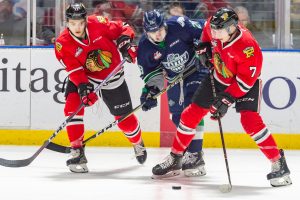
Meanwhile, Kvasnica continues to generate chances and is finding the puck between the dots. His goal production is still developing, but when he is on the ice, more often than not, play is in the offensive zone. I have been an advocate for giving the Czech import some looks on the power play. Being a skilled player, playing Kvasnica on the man advantage gives him time and space to make plays.
When Josh Paterson controls his office, in front of the net and top of the crease, he creates havoc for other teams. Getting used to a new team and their systems takes time, and the former Saskatoon Blade now has ten games under his belt. As his linemates get used to his tendencies, and the wingers/defensemen on the power play shoot to utilize the screens he provides, Paterson’s true value to the team can be utilized.
Final Schedule breakdown
Portland has 17 games remaining, 11 on the road and six at home. The Winterhawks home games are an even split, three in the Moda Center and three in the Veterans Memorial Coliseum. However, the next three home games are in the Moda Center with the final three of the home games will be in the VMC. The Rose Quarter determines the venue for any playoff games.
A quick glance at Portland’s (69 points) opponents in the final quarter of the season:
- Everett (76 points) – Two games – one on the road and one at home
- Vancouver (69 points) – One game on the road
- Medicine Hat (60 points) – One game at home
- Red Deer (59 points) – One game at home
- Spokane (58 points) – One game at home
- Tri-City (55 points) – Two games on the road
- Kelowna (45 points) – Two games on the road
- Seattle (44 points) – Five games – three on the road and two at home
- Prince George (37 points) – Two games on the road
Ten of Portland’s last 17 games are within the division, including the five with Seattle.
Nine of the Winterhawks games are against a team with a losing record, including six of their last seven games (Everett the exception).
On the final weekend of the season, Portland and Seattle face-off in a home-in-home series. The last game of the regular season is in the Rose City.
Playoff outlook
If the playoffs began tomorrow, and they do not, Portland would finish second in the U.S. Division, seven points behind the Everett Silvertips. That said, their magic number to make the playoffs is down to 13 points. This means a combination of 13 points won by Portland or ninth place Seattle dropping 13 points.
Using the standings as of Monday evening, the Winterhawks first-round matchup would be identical to a season ago, the Spokane Chiefs. Like last year, the Winterhawks finishing position grants them home ice in the series. The winner of the series stays on the U.S. Division side of the bracket, meaning the winner of the Everett/Kelowna series.
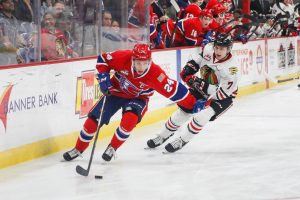
In five games, the Winterhawks are 3-2 against the rival Chiefs; however, this record should have an asterisk next to the total. Jaret Anderson-Dolan, Ty Smith, Filip Kral, and Cody Glass each have missed at least two of the five games. Joachim Blichfeld and Ty Smith missed the majority of the most recent game as well.
The other most likely first round candidate for the Winterhawks is the Tri-City Americans. The Americans hold a better record against Portland with the Americans winning five of the first six games. However, four of Tri-City’s wins have come in the three-on-three overtime session or shootout. Both formats are not used in the playoffs as overtime is continuous five-on-five play until a goal is scored.
At this point of the season, dependent on any major injuries, I stand by my mid-season position where Portland is not able to catch Everett for the division title. I also do not see either Spokane or Tri-City making up the 11 and 14 points respectively. The race for third in the U.S. Division should be a fun competition to watch.
I will complete one last review after the regular season concludes.

